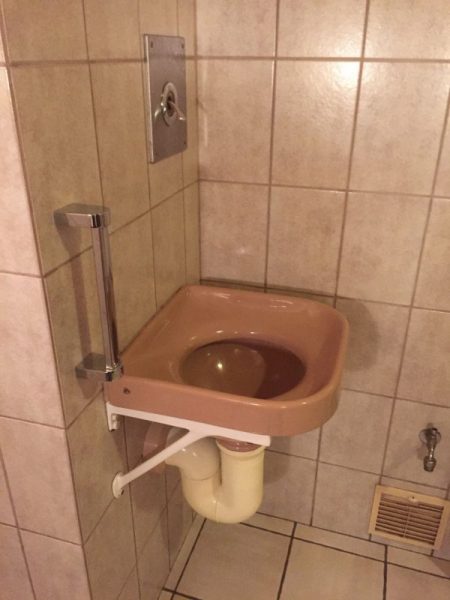It was supposed to be a harmless bit of day drinking. Me, my cousin-in-law and a vanilla small-town pub in central Germany. My wife had supported the decision because it got me out of her hair as she wrangled our kids and her parents – my in-laws – over coffee and cake at grandma’s. I was out of her mind, I figured, and could concentrate on the beer, and she figured I was safe with her cousin.
Nobody would have suspected something unsettling was about to unfold.
It happened when I had to pee after the second beer, or maybe the third, depending on how much juice I’d had with breakfast. As I came into the pub’s bathroom everything seemed normal. I noted a sink on my left and floor-to-ceiling tiles in that light-brown tint that’s so popular in public restrooms in western regions of Germany.

“What is Germany trying to tell me with that color in a bathroom?” I always think. I’ve never gotten an answer because I’ve never asked the question out loud – the Teutonic propensity for shelf toilets and public discussions of bathroom visits has me fearful of the answer.
As I stood there doing my business, I noticed a second sink off to my left. It was shaped differently and seemed to have supports on one side.
“Must be a utility sink for mops,” I thought. When I was done, I took a closer look. It was a weird sink with a wide drain, like on American sinks with garbage disposals, and a water switch. Something told me this wasn’t a utility sink but I had no idea what it was for, the same feeling I get every time I’m confronted with a salad bar.
I went back out to the bar and asked my cousin-in-law Basti what the weird sink was.
“Das Speibecken?” he asked, as if that would settle it. As if hearing that word would clear up the confusion.
“Yes,” I said. “What’s it for?”
Because ‘Speibecken’ sounded like German for “Weird sink” but I still didn’t know what it was.

Basti started to laugh and announced to the bar what a funny foreigner I was – I’d never heard of a Speibecken! The bar (one other drinker and a bartender) laughed with him.
We all had a good laugh.
I still had no idea what a Speibecken was.
“It’s for when you drink too much and you have to puke,” he announced, as if every bar in the world had a Speibecken. The entire bar looked at me with great sympathy, wondering with their eyes if this was the first bar I’d ever been in.
This must happen to every ex-pat every now and then – you stumble into something the natives think is part of the human condition but isn’t. It’s that weird moment where Germany doesn’t know it’s doing something strange and you have to be the one to break the bad news.
“Puke?” I wondered.
With that, Basti leaped off his stool and he, I, and the other drinker headed into the bathroom for a round of simulated puking. I don’t want to say that Basti seemed to have experience, but he seemed to have experience.
Das Speibecken
I took a picture and showed it around the office on Monday.
“Oh yeah,” my German co-worker said. “They’re also called a Pabst (Pope) and when you use it you’re papsten (poping).” Which is taking the colloquial saying, ‘Praying to the porcelain god’, to the next level.
My co-worker said Speibecken are especially popular in German fraternity houses, something Wikipedia backs up. As a journalist, I’m skeptical of Wikipedia but I’m not sure who to call to double-check the info on a puke sink.
As it turns out, my German wife is more of a puke sink expert than I would have thought. “You have to mention how there’s standards that call for a specific diameter of drain to accommodate the half-digested food,” she said as I wrote this blog. “That’s important.”
Important to who?
She didn’t know much about the terminology.
The word Speibecken actually means ‘spittoon’ and is also used for that little sink at the dentist’s you spit into – or in the saloon, presumably.
And the term Pabst apparently has less to do with that grown man in the Vatican who wears pajamas all day than the Latin for puking – because we all know the Romans invented leisure puking.
The Germans just seem to have perfected it.
5 Comments